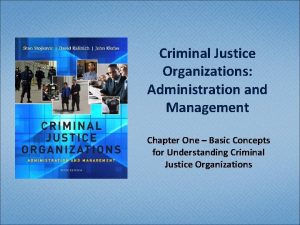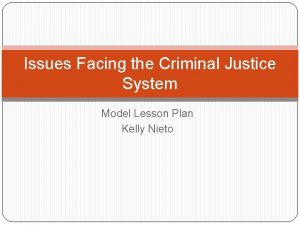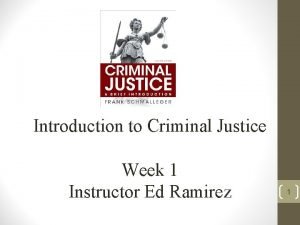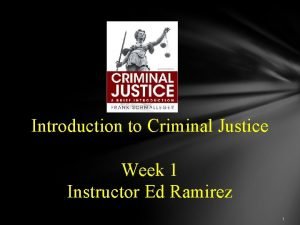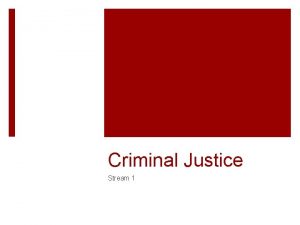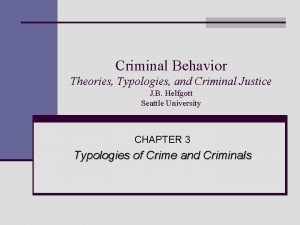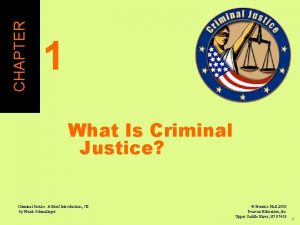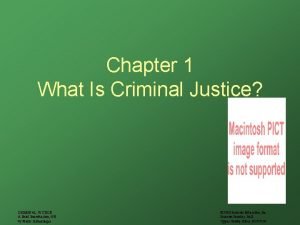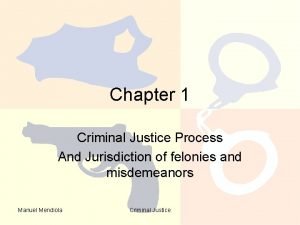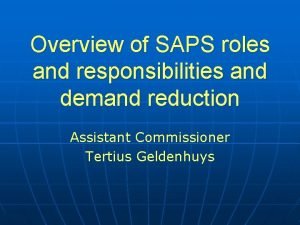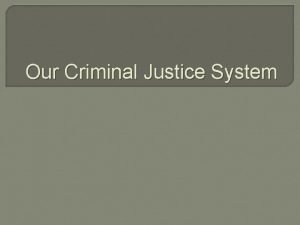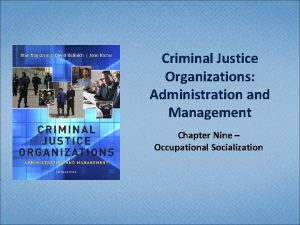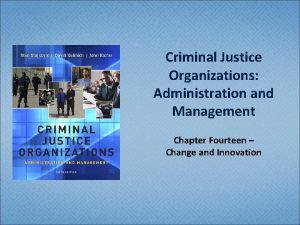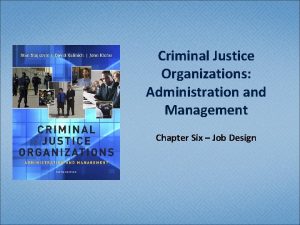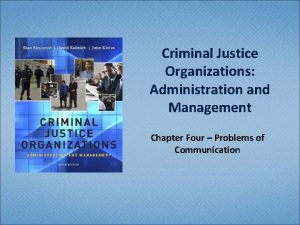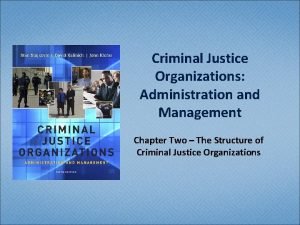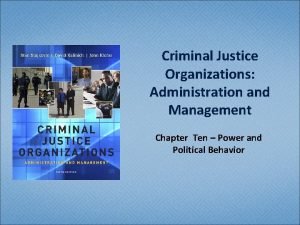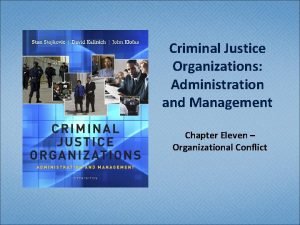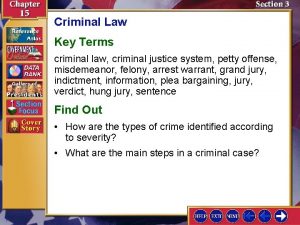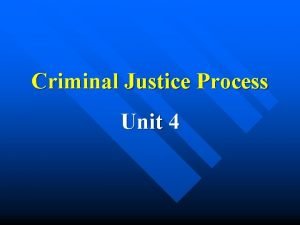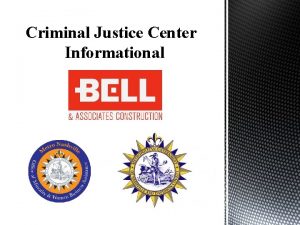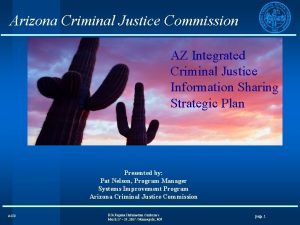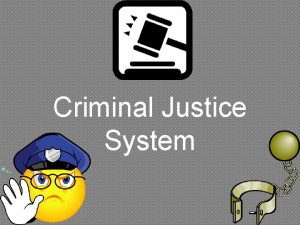Criminal Justice Organizations Administration and Management Chapter Five






















- Slides: 22

Criminal Justice Organizations: Administration and Management Chapter Five – Motivation of Personnel

Learning Objectives § Understand a definition of motivation. § Comprehend organizational theory and motivation from a historical perspective. § Know the major theories of motivation. § Explain some prescriptions for criminal justice management regarding motivation. § Understand an integrated model of motivation.

Motivation Defined § Motivation can be understood from two perspectives o Psychological • Examine an individual’s state of mind to understand his or her behavior. • Individual value systems produce attitudes and motivation. o Organizational • Explore managerial behaviors that induce employees to behave in certain ways. • Provide mechanisms that enable employees to be highly motivated.

A Historical Perspective of Motivation § Classical school (Taylor, Fayol, Follett) o Motivation is primarily a managerial responsibility, i. e. to create clearly defined rules and supervision strategies. o Employees were thought to be selfmotivated if managers did their jobs.

A Historical Perspective of Motivation § Human relations school (Barnard, Drucker, Demming, Schein et. al. ) o Motivation is an interactive process between workers and supervisors. o Motivation is influenced by how supervisors treat their employees. o Manager/worker relationships are cultivated to achieve organizational goals.

A Historical Perspective of Motivation § Behavioral school o Emphasizes the importance of manager and leader behavior and other administrative actions to employee motivation. o Focusing on behaviors and proper interactions will produce more motivated employees. § The study of organizational development originated from the human relations and behavioral schools of motivation.

Motivation Theories § Need Theory (Maslow, 1943) o All people have needs which affect their behavioral patterns. o Five basic needs • • • Physiological Safety/security Belonging Esteem Self-actualization o Humans are motivated (individually) by their most basic need.

Motivation Theories § Need Theory (Maslow, 1943) o When lower level (primary) needs (physiological, safety/security) are met then they no longer become motivators. o Then managers must focus on motivating employees through higher order needs like belonging, esteem and self-actualization.

Motivation Theories

Motivation Theories § Theory X and Theory Y (Mc. Gregor) • Two approaches based on assumptions about human behavior. o Theory X • Management organizes the elements of a productive enterprise. • Management directs, motivates, controls and modifies the behavior of employees to fit organizational needs. • Without managerial intervention people would ignore organizational needs. o Theory Y • Management organizes the elements of a productive enterprise. • People are neither ignorant of nor or resistant to organizational needs. • Motivation is present in all people.

Motivation Theories § Achievement-Power-Affiliation (Mc. Clelland) o People with high achievement values; Seek success through their own efforts, Do not attribute their success to other factors, Work on projects that are challenging but not impossible, Receive identifiable and recurring feedback about their work, and • Avoid situations where their level or achievement is in question. • • § Expectancy theory o A rational approach to motivation o If a certain amount of effort is put forth, a calculated outcome will result. o Motivation is based on an expectation of success.

Motivation Theories

Motivation Theories

Motivation Theories

Motivation Theories § Equity theory o An individual’s motivation is affected by his or her perception of fairness in the workplace. o Individual motivation must be understood in relation to how other employees are treated by management and the organization.

Motivation Theories § Theory Z (Ouchi) o Management is concerned with production. (Theory X) o Management is concerned with the well-being of workers as productive employees. (Theory Y) o The organization cannot be viewed independent of its environment (social, political, economic). o The work setting must be understood in conjunction with other institutions in society, like family and school.

Prescriptions for Criminal Justice § Quality circle programs o Interactions among employees should provide for the maximum growth of the individual. o In doing so, the organization will become increasingly effective. § Management by Objectives (MBO) o Individual managers and employees identify goals o Both work toward their completion o Evaluation of progress within a specific time period.

Prescriptions for Criminal Justice § An Integrated Model of Motivation o Emphasis on personal motives and values o Use of incentives and rewards o Reinforcement o Sufficient personnel and material resources o Interpersonal and group processes that support members’ goals.

Prescriptions for Criminal Justice

Chapter Summary § Motivation is both a psychological construct as well as an organizational construct. § The motivation process can be defined and must be understood as evolving over a long period of time. § There a number of theories of motivation. o Need theory o Theory X and Theory Y o Achievement-power-affiliation theory o Expectancy theory o Equity theory o Theory Z § Each of these theories explain motivation within the criminal justice system.

Chapter Summary § The motivation of criminal justice employees requires recognition that employee needs, abilities, and opinions are critical. § There have been to prescriptive models of motivation tested in criminal justice organizations o Quality circles o Management by objectives § An integrated model of motivation that incorporates many different theories may be the most beneficial to criminal justice administrators.

Thinking Point and Question § Faced with severe fiscal problems the State Legislature has been forced to furlough (lay-off) ten percent of its work force. § In addition to substantial security concerns, the Director of the State Department of Corrections must insure the remaining employees in her agency are sufficiently motivated. § Using one of the motivation theories discussed in this chapter as a guide, describe how you would advise the Director to develop a comprehensive employee motivation program.
 Management in criminal justice organizations
Management in criminal justice organizations Guelph university criminology
Guelph university criminology Define corrections in criminal justice
Define corrections in criminal justice Criminal law and juvenile justice unit 2
Criminal law and juvenile justice unit 2 What are the branches of criminal justice system
What are the branches of criminal justice system Connecticut division of criminal justice
Connecticut division of criminal justice What is the criminal justice funnel
What is the criminal justice funnel What is a grass eater in criminal justice
What is a grass eater in criminal justice Eighth amendment excessive bail
Eighth amendment excessive bail Consensus model criminal justice
Consensus model criminal justice Consensus model criminal justice
Consensus model criminal justice 4 pillars of justice
4 pillars of justice Consensus model criminal justice
Consensus model criminal justice Typologies of crime
Typologies of crime Individual rights
Individual rights Consensus model criminal justice
Consensus model criminal justice Consensus model criminal justice
Consensus model criminal justice Nonintervention perspective of criminal justice
Nonintervention perspective of criminal justice Wedding cake model of criminal justice
Wedding cake model of criminal justice Arizona criminal justice information system
Arizona criminal justice information system Responsibilities of saps in the criminal justice system
Responsibilities of saps in the criminal justice system Nys division of criminal justice services
Nys division of criminal justice services National archive of criminal justice data
National archive of criminal justice data
